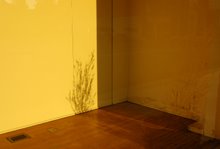





William Christenberry provides a nice pairing/follow up to Eggleston because they are both important to the history of color photography and because they both primarily photograph the American South. While Eggleston wouldn't want to be known as a regionalist, Christenberry is open about his love for and connection to his home state of Alabama, particularly Hale County.
Since the mid-sixties, Christenberry has been shooting buildings/vernacular architecture around Hale County (where Walker Evans took the photos for his collaborative effort on tenant farmers with James Agee, Let Us Now Praise Famous Men). After graduating from the University of Alabama, he began taking photos of local buildings to use for his abstract expressionist paintings. Up until recently, all of his photos were taken with an inexpensive Kodak Brownie camera, the cheap lense adding to the faded quality already present in his subject matter.
I'm personally drawn to Christenberry for a number of reasons, one of which is that I share his desire to preserve aspects of the South that are changing, disappearing. Although most of his photos are simple, straightforward shots of buildings, he manages to create a feeling and atmosphere similar to what one finds the writings O'Connor, Faulkner, and Welty (the quote "the South is a state of mind" comes to mind). Throughout the South (and everywhere else, really), that distinct atmosphere is changing, giving way to a world of shopping malls, chain restaurants, suburbs, homogenization. Christenberry's photos don't look back on the past with nostalgia necessarily (although nostalgia originally meant homesickness, and Christenberry's photos are undeniably connected to Alabama as "home"). Still, he doesn't present his "home" with an easy sentimentality; rather, he shows the positives and negatives, the "jubilee and knell" (one of Christenberry's more controversial shows is the "Klan Room," which includes various sculptures, drawings, paintings, and so on related to racism in the South).
One major point about Christenberry that I've neglected to mention is that he photographs many of the same places year after year, showing the passage of time and his ongoing dialogue with the place. He has photographed many of the same buildings since 1968 (i.e.--the green one in this post). Many have remained relatively the same, and others went through various transformations before being torn down. In addition to photographing vernacular architecture, Christenberry also creates amazingly realistic sculptures of some of the buildings, occassionally using the actual dirt from the place as a base, and like his friend and mentor Walker Evans he collects old signs (the last photo in the post).
There's a directness to Christenberry's photos that I really like. While typing this entry, I've been thinking of William Carlos Williams' poems, specifically:
so much depends
upon
a red wheel
barrow
glazed with rain
water
beside the white
chickens.
As an undergrad I thought this poem was meaningless, that it was too simple to say anything. As I've gotten older, though, I've grown to appreciate the simplicity of the poem. In part, the poem is a response to Eliot's "The Wasteland," an abstruse poem laden with allusions to myth and esoteric literature. Whereas Eliot (an expatriot) largely embraced a European intellectual tradition, Williams wanted to create an "American" poem in vernacular language. Similarly, Christenberry's photos can be looked at as small, direct poems to Hale County. They are simple, but not simplistic. Perhaps the "so much" in Williams' poem is his entire world-view, everything that he loves. In a similar way, I think Christenberry's simple photos of modest buildings can tell us much about who he is and the place that helped shape him.

2 comments:
I've been enjoying your posts on the Eggeleston and Christenberry, a couple of my favorites as well. The Williams poem seems appropriate while looking at the Christenberry photos, simple and direct while creating a mood. I also have a desire to preserve something of the South that is detoriating and enjoy taking back roads through small towns whenever I can. If nothing else it's a lot more fun than bypassing everything on the interstate.
kurney,
you should check out the documentary Searching for the Wrong-Eyed Jesus. It follows musician Jim White down back roads in the South searching for the out of the ordinary. To a certain degree, it traffics in stereotypes, but it has footage of some interesting places, good scene with autor Henry Crews.
Post a Comment